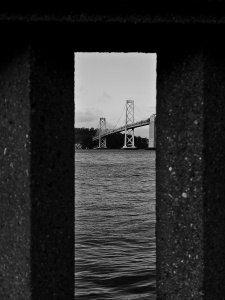Exposure Triangle
Last week I introduced 6 aspects of a photograph that are important to consider when taking pictures. Perhaps the most important of these is exposure, and so I want to talk a bit about that today and offer my explanation of the Exposure Triangle, something that often trips up new photographers.
Essentially there are three things that influence how much light you get into a picture (both film and digital). They are the lens aperture, the camera shutter speed, and the film (or sensor) ISO setting. These three things go together to make up the exposure triangle.
Aperture (measured in f-stops) is the size of hole that opens when you press the shutter. f/1.8 is a large hole, f/16 is much smaller. Each ‘stop’ doubles the amount of light by doubling the area of the hole. Going from f/11 to f/8 is one stop, double the light. Think of it like the diameter of a circle;
A circle with a diameter of 1/11 of an inch has an area of 0.006136 in².
A circle with a diameter of 1/8 of an inch has an area of 0.012272 in² – double the area.
The smaller the f/ number the bigger the hole.

In reality f-stops are often measured in thirds so you would go f/11 to f/10 (one third) to f/9 (two thirds) to f/8 (one whole stop) in one third increments.
Camera shutter speed is simply the time that the shutter is open and allowing light in – measured in fractions of a second.
You can also think of shutter speed in terms of ‘stops’ – doubling the length of time the shutter is open doubles the amount of light. So going from 1/250 of a second to 1/125 doubles the time, doubles the light and is equal to one stop.
As with aperture, we work in third stop increments of shutter speed so it goes 1/250 to 1/200 (one third) to 1/160 (two thirds) to 1/125 (one whole stop) in one third increments.
These two parameters can be manipulated together to retain a good exposure.
For example, if you have a well exposed shot at f/8 and 1/60 of a second but there is movement in the image that you want to freeze you can speed up the shutter by two whole stops to 1/250 of a second (1/125 is one stop) but this means two stops less light. So to maintain the exposure you need, add two stops more light back by adjusting aperture, f/8 to f/5.6 is one stop and to f/4 is two stops. So the same exposure will be achieved by using f/4 at 1/250.
ISO (or occasionally called ASA) is a measure of film (or sensor) sensitivity to light.
A ‘slow’ film might have and ISO of 100, faster film ISO 400. Unfortunately higher ISO film, while faster, produces a grainy texture which is not always desirable. Higher ISO on a digital camera produces ‘noise’ which should also be avoided.
As with shutter speed and aperture, ISO levels are measured in stops – 200 ISO film is twice as fast as 100 ISO, 400 ISO film is twice as fast as ISO 200. In both cases double the amount of light is registered therefore 1 stop more of exposure.
So in the above example if you went from f/8 and 1/60 at ISO 100 to 1/250 of a second (two stops lower), you could maintain the correct exposure by shooting at ISO 400 (two stops faster) and not have to change the aperture from f/8.
Hence these three parameters can be adjusted to get the correct exposure whilst also maintaining a desirable aperture or shutter speed (and I’ll talk about why you might want to get a certain aperture or shutter speed next time).
Because the three are inter-related they are often referred to as the Exposure Triangle.
btw the above is a shot of an exhibit by the Danish artiest Bjorn Dahlem at the Saatchi Gallery in London, taken in 2007.





